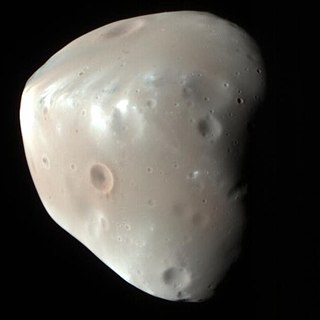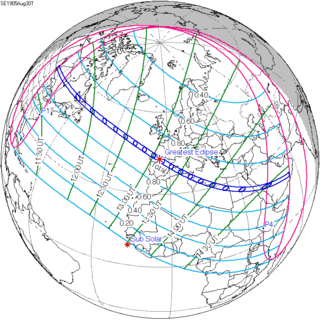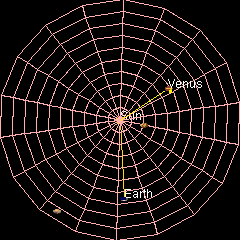Related Research Articles

The astronomical unit is a unit of length, roughly the distance from Earth to the Sun and equal to 150 million kilometres or 8.3 light minutes. The actual distance from Earth to the Sun varies by about 3% as Earth orbits the Sun, from a maximum (aphelion) to a minimum (perihelion) and back again once each year. The astronomical unit was originally conceived as the average of Earth's aphelion and perihelion; however, since 2012 it has been defined as exactly 149597870700 m.

An eclipse is an astronomical event that occurs when an astronomical object or spacecraft is temporarily obscured, by passing into the shadow of another body or by having another body pass between it and the viewer. This alignment of three celestial objects is known as a syzygy. Apart from syzygy, the term eclipse is also used when a spacecraft reaches a position where it can observe two celestial bodies so aligned. An eclipse is the result of either an occultation or a transit.

A lunar calendar is a calendar based on the monthly cycles of the Moon's phases, in contrast to solar calendars, whose annual cycles are based only directly on the solar year. The most commonly used calendar, the Gregorian calendar, is a solar calendar system that originally evolved out of a lunar calendar system. A purely lunar calendar is also distinguished from a lunisolar calendar, whose lunar months are brought into alignment with the solar year through some process of intercalation. The details of when months begin varies from calendar to calendar, with some using new, full, or crescent moons and others employing detailed calculations.

Mercury is the smallest planet in the Solar System and the closest to the Sun. Its orbit around the Sun takes 87.97 Earth days, the shortest of all the Sun's planets. It is named after the Roman god Mercurius (Mercury), god of commerce, messenger of the gods, and mediator between gods and mortals, corresponding to the Greek god Hermes (Ἑρμῆς). Like Venus, Mercury orbits the Sun within Earth's orbit as an inferior planet, and its apparent distance from the Sun as viewed from Earth never exceeds 28°. This proximity to the Sun means the planet can only be seen near the western horizon after sunset or the eastern horizon before sunrise, usually in twilight. At this time, it may appear as a bright star-like object, but is more difficult to observe than Venus. From Earth, the planet telescopically displays the complete range of phases, similar to Venus and the Moon, which recurs over its synodic period of approximately 116 days.

Venus is the second planet from the Sun and is named after the Roman goddess of love and beauty. As the brightest natural object in Earth's night sky after the Moon, Venus can cast shadows and can be visible to the naked eye in broad daylight. Venus's orbit is smaller than that of Earth, but its maximal elongation is 47°; thus, at latitudes with a day-night cycle, it is most readily visible for up to a few hours following the start of sunset or before sunrise. At times, it has been seen in a completely dark sky. Venus orbits the Sun every 224.7 Earth days. It has a synodic day length of 117 Earth days and a sidereal rotation period of 243 Earth days. Consequently, it takes longer to rotate about its axis than any other planet in the Solar System, and does so in the opposite direction to all but Uranus. This means that the Sun rises from its western horizon and sets in its east. Venus does not have any moons, a distinction it shares only with Mercury among the planets in the Solar System.
The Julian day is the continuous count of days since the beginning of the Julian period, and is used primarily by astronomers, and in software for easily calculating elapsed days between two events.

Sidereal time is a timekeeping system that astronomers use to locate celestial objects. Using sidereal time, it is possible to easily point a telescope to the proper coordinates in the night sky. In short, sidereal time is a "time scale that is based on Earth's rate of rotation measured relative to the fixed stars", or more correctly, relative to the March equinox.

In astronomy, a conjunction occurs when two astronomical objects or spacecraft have either the same right ascension or the same ecliptic longitude, usually as observed from Earth. The astronomical symbol for conjunction is ☌ and handwritten . The conjunction symbol is not used in modern astronomy. It continues to be used in astrology.

Deimos is the smaller and outermost of the two natural satellites of Mars, the other being Phobos. Deimos has a mean radius of 6.2 km (3.9 mi) and takes 30.3 hours to orbit Mars. Deimos is 23,460 km (14,580 mi) from Mars, much farther than Mars's other moon, Phobos. It is named after Deimos, the Ancient Greek god and personification of dread and terror, and who is also a son of Ares and Aphrodite and the twin brother of Phobos.

In astronomy, a transit is a phenomenon when a celestial body passes directly between a larger body and the observer. As viewed from a particular vantage point, the transiting body appears to move across the face of the larger body, covering a small portion of it.
A synodic day is the period for a celestial object to rotate once in relation to the star it is orbiting, and is the basis of solar time.

A transit of Venus across the Sun takes place when the planet Venus passes directly between the Sun and a superior planet, becoming visible against the solar disk. During a transit, Venus can be seen from Earth as a small black dot moving across the face of the Sun. The duration of such transits is usually several hours. A transit is similar to a solar eclipse by the Moon. While the diameter of Venus is more than three times that of the Moon, Venus appears smaller, and travels more slowly across the face of the Sun, because it is much farther away from Earth.

A transit of Mercury across the Sun takes place when the planet Mercury passes directly between the Sun and a superior planet. During a transit, Mercury appears as a tiny black dot moving across the Sun as the planet obscures a small portion of the solar disk. Because of orbital alignments, transits viewed from Earth occur in May or November. The last four such transits occurred on May 7, 2003; November 8, 2006; May 9, 2016; and November 11, 2019. The next will occur on November 13, 2032. A typical transit lasts several hours. Mercury transits are much more frequent than transits of Venus, with about 13 or 14 per century, primarily because Mercury is closer to the Sun and orbits it more rapidly.

A total solar eclipse occurred on August 30, 1905. A solar eclipse occurs when the Moon passes between Earth and the Sun, thereby totally or partly obscuring the image of the Sun for a viewer on Earth. A total solar eclipse occurs when the Moon's apparent diameter is larger than the Sun's, blocking all direct sunlight, turning day into darkness. Totality occurs in a narrow path across Earth's surface, with the partial solar eclipse visible over a surrounding region thousands of kilometres wide. Totality was visible from Canada, Newfoundland Colony, Spain, French Algeria, French Tunisia, Ottoman Tripolitania include the capital Tripoli, Egypt, Ottoman Empire include Mecca, Emirate of Jabal Shammar, Aden Protectorate, and Muscat and Oman.

In astronomy, a syzygy is a roughly straight-line configuration of three or more celestial bodies in a gravitational system.

The Solar Hijri calendar is a solar calendar and one of the various ancient Iranian calendars. It begins on the March equinox as determined by astronomical calculation for the Iran Standard Time meridian and has years of 365 or 366 days. It is the modern principal calendar of both Iran and Afghanistan, and is sometimes also called the Shamsi Hijri calendar, and abbreviated as SH and, sometimes, HS.

Venus has an orbit with a semi-major axis of 0.723 au, and an eccentricity of 0.007. The low eccentricity and comparatively small size of its orbit give Venus the least range in distance between perihelion and aphelion of the planets: 1.46 million km. The planet orbits the Sun once every 225 days and travels 4.54 au in doing so, giving an average orbital speed of 35 km/s (78,000 mph).

Maya astronomy is the study of the Moon, planets, Milky Way, Sun, and astronomical phenomena by the Precolumbian Maya Civilization of Mesoamerica. The Classic Maya in particular developed some of the most accurate pre-telescope astronomy in the world, aided by their fully developed writing system and their positional numeral system, both of which are fully indigenous to Mesoamerica. The Classic Maya understood many astronomical phenomena: for example, their estimate of the length of the synodic month was more accurate than Ptolemy's, and their calculation of the length of the tropical solar year was more accurate than that of the Spanish when the latter first arrived. Many temples from the Maya architecture have features orientated to celestial events.
L 98-59 is a bright M dwarf star, located in the constellation of Volans, at a distance of 10.623 ± 0.003 parsecs, or 34.648 ± 0.01 light-years, as measured by Gaia.
References
- ↑ "Astronomical day". The Free Dictionary . Retrieved 1 August 2013.
- 1 2 Campbell, W.W. (1918). "The Beginning of the Astronomical Day". Publications of the Astronomical Society of the Pacific. 30 (178): 358. Bibcode:1918PASP...30..358C. doi: 10.1086/122784 .
- ↑ Finkleman, David (2011). "The Future of Time: UTC and the Leap Second". arXiv: 1106.3141 [astro-ph.IM].
- ↑ "Logbooks of the Bologna astronomical Observatory for the year 1761". Transits of Venus. University of Oxford. Archived from the original on 4 March 2016. Retrieved 29 August 2013.
- ↑ "Transit of Venus Bibliography". Institute for History and Foundations of Mathematics and the Natural Sciences. Retrieved 29 August 2013.


